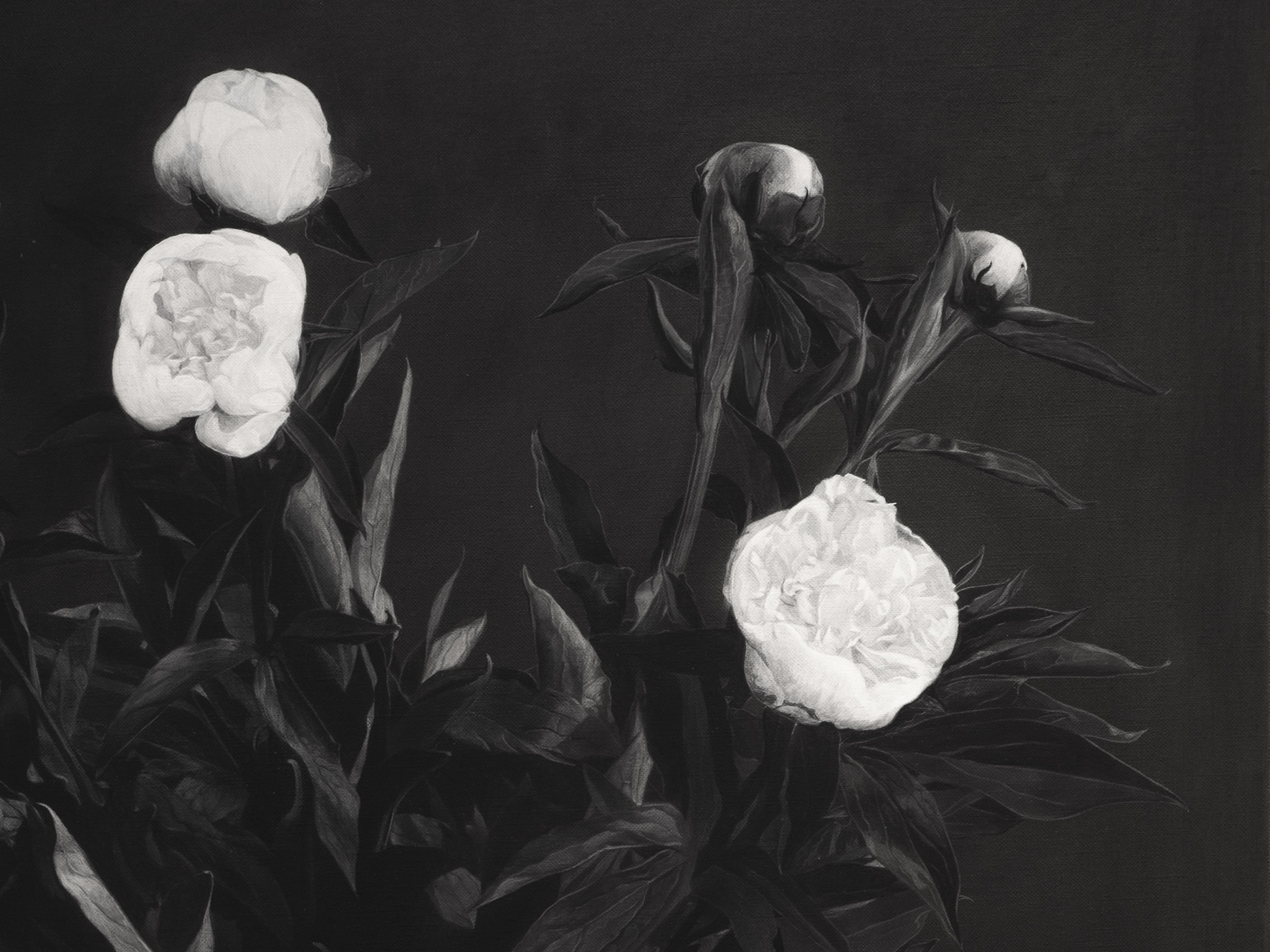Don Brown’s Seven Paintings is the first in our new series of online exhibitions, HOMEWORK, featuring works made in the studios and homes of artists during the sequestered days of Covid-19.
Comprising seven canvases, this show marks a decisive new phase for Brown, who is best known for his meticulously wrought sculptures of the human figure. His new oil paintings – each a grisaille depiction of flowers – pick up on threads that have run through his practice from the beginning – the implicit animation of static forms, for instance, and the coincidence of minutely observed reality with historical or mythic resonances.
Made over the last two months in his home studio in Suffolk, Brown’s new paintings are the result of a three-year exploration of painting. Each presents a close-up view of flowers, either arranged in vases or isolated (as single weightless forms) on a pregnant black ground. Echoing the shades of his sculptures in bronze and acrylic, the paintings both embrace and re-orientate the genre of flower painting, evacuating the motif of colour while paying acute – almost forensic – attention to the texture and tonal subtlety of each subject.
The palette in this way reflects a broader dynamic, persisting throughout Brown’s work, between profound intimacy and self-conscious detachment: the tonality of the pictures throws into relief the particularity and idiosyncrasy of the flowers (their variety of lacy, fluted surfaces; their distinct shapes) while also implying a veil or intermediary between the subject and the artist or viewer. Each painting is, accordingly, a straightforward testament to a real-life object, observed in the present-tense (the artist has remarked on the literal, “unarguable” quality of flowers), and an imaginative formulation that suggests the intercessions of memory, symbolism and art history. Painted both from direct observation and, in the case of the two works titled Roses (after Fantin-Latour), from reproductions of nineteenth-century paintings, their points of reference span different epochs and traditions, whether Japanese flower painting or Dutch still life. In each instance, perception is distilled into parallel acts of seeing and feeling, in a process that the artist has compared to Marcel Proust’s observation that “only that which bears the imprint of our choice, our taste, our uncertainty, our desire and our weakness can be beautiful.”
The turn to painting that this exhibition marks is also a continuation of a long-term aspect of Brown’s practice: he has painted and drawn in tandem with his career as a sculptor. The new pictures translate into pictorial form the underlying concerns of his sculptural work, above all the confluence (seen in his long-term series of sculptures of his wife, Yoko) of specificity and universalism, whereby the modelled figure is both a portrait and a transhistorical spectre. “Though there is relationship to ‘real’ flowers,” he has commented of the new series, “in a way flowers are symbols of themselves.”
The theme of time is magnified, moreover, by the embrace of a subject that is, by definition, transient and mutable. “I’m wrestling with the idea of trying to make an image and fix it, while the thing itself is changing,” he has remarked. In several pictures, he captures this element of flux – achieving a concurrent sense of blooming life and imminent decay. The massed petals in Hydrangeas, emerging on dark stems from the ‘pedestal’ of a milk bottle, resemble a cloud – arrested between coalescence and dispersal. The heavy petals of the roses after Fantin-Latour seem to presage their own fall to earth.
Don Brown (b. 1962, Norfolk) studied at the Central School of Art (1983-5) and the Royal College of Art (1985-8). He has exhibited in galleries and museums internationally, including a solo presentation at Le Consortium, Dijon (2007). He has been included in exhibitions including Selected works from the Murderme collection, Newport Street Gallery, London (2017); Theatrical Gestures, Herzliya Museum of Contemporary Art, Israel (2013); Presence: the art of the sculpted portrait, Holburne Museum, Bath (2012); Freedom Not Genius, Pinacoteca Giovanni e Marella Agnelli, Turin (2012); and The Naked Portrait, Scottish National Portrait Gallery, Edinburgh (2007). His work is in public collections including that of Tate. A book on the Yoko sculptures was published by Other Criteria in 2013, featuring an essay by Darian Leader.
For further information please contact the gallery at +44 (0)20 7493 8611 or press@sadiecoles.com
